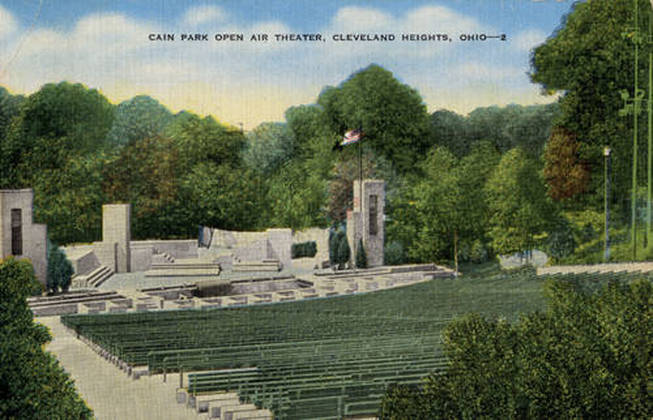A few months previous, I had met with Kieth Peppers, Calvin Rydbom, and Thomas Kubat of Pursue Posterity to discuss the project. At that time, gave me a book to look over entitled Cain Park Theatre: The Halcyon Years, by Dr. Dina Rees Evans. I had also done some research online, so I had a basic idea of the history and timeline of events surrounding the venue. However, seeing actual letters composed by manual typewriter on onionskin paper dating from the World War II era conveyed a much greater sense of meaning. This is what draws people to archival work, the opportunity to work with primary source materials, preserving and organizing them in a way that allows others to experience the same joy of discovery. I soon realized that my first challenge with this project would be deciding which of the many stories of Cain Park I wanted to tell with my limited time and resources.
As I looked through box after box of materials, I realized that a large portion of them were from the “modern” era of Cain Park, the 1990s-2010s. Almost immediately, I decided that this material was too current to be of historical interest, and also in such good condition that it was not a high priority for immediate preservation. These boxes could afford to wait for the attentions of a future archivist. Moving down the shelves, I also found that the late 1970s and 1980s were fairly well-represented. As child of the 1980’s, it was tempting for me to want to go through and work with the material of that time period, but I decided that the general public might not find it quite as interesting as me and my fellow Gen X-ers. These boxes, too, could wait. The chronologies of Cain Park had prepared me to expect a notable gap of boxes from the 1960s and early 1970s, a period during which the Park was mostly not in operation.
Finally, I located the oldest collected materials which represented the first twenty years of the theater venue, 1938-1959. I was both pleasantly surprised and a little intimidated by the volume of materials from this era. Fortunately, I soon learned that I would not have to start my project from scratch. My predecessor, Emily Smith, spent the summer of 2012 organizing a good deal of the material from this time period. Unlike the materials from the other eras of Cain Park, the photographs from this period were organized by year, production,and personnel. Where it was not possible to be this exact, they were placed in general folders by decade. Emily also organized the scrapbooks by year, scanned a lot of photos into the computer in JPEG and TIFF formats, and organized the program booklets by year and decade. It appears that she did not have the time to work the boxes containing other written materials, such as inventories, attendance and box office records, and correspondence.
The work Emily had done allowed me to quickly see that this early period of Cain Park, particularly the 1940s, was the most well-represented, both in terms of quantity and quality of materials available. However, even this narrow window of time presented numerous compelling stories to tell.
The historical narrative of Cain Park begins in the mid-1930's, as the country struggled to emerge from the Great Depression. This is when Mayor Frank Cain and Captain Harvey Hecker (of the Cuyahoga County Soldiers and Sailors Relief Commission) built the park with the labor of disabled veterans, funds from the Works Progress Administration (WPA), and donations from individuals such as John D. Rockefeller, Jr. Around this same time, Dr. Dina Rees Evans (the first person in the country to earn a doctorate in Theatre Arts), began to envision Cain Park the perfect location for an outdoor civic theater. A drama teacher at Cleveland Heights High School, Dr. Evans would serve as director of Cain Park Theatre for several decades. It is hard to imagine how large her influence must have been on our nation's drama programs through her work in the classroom as well as the summer Children's and Youth Theatre programs at the Park. The success of Cain Park's Theatre's adult productions during this era is also remarkable, considering that the population faced the trials of war and the theater directors had to compete for an audience's attention with no less a rival than the “Golden Age” of Hollywood. The 1940s were by far the most active period of Cain Park Theatre, with an amazing 80 plays staged (more than a third of total productions over the entire history of the venue). In addition to being prolific, the Theatre also turned a profit every year.
When I told Calvin, who is advising me on this project, what materials I had discovered and the various stories I would like to tell on the Memory Project exhibit, he cautioned me about trying to tackle too much. While I was a little bit reluctant to narrow the scope of my project, I recognized that it would be necessary in order to make sure I would be able to complete it by the end of the summer. I also realized that this approach would allow me take more time and show greater respect for the materials and era which I chose to focus on. After some thought, I decided to focus on the time period from 1938-1950, with special emphasis on the mid-1940s and WWII. I have also decided to focus on the adult theater productions, because of the quality of the photographs and programs which Emily had already started to organize. These are the materials that are of the greatest historic importance and widest interest to the public and, as the oldest materials in the collection, represent a high preservation priority. For now, the story of the Children's Theatre and the 1950's will have to wait for the next student looking for an internship in archival work.

 RSS Feed
RSS Feed
